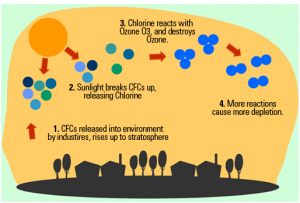Main Chemical Concepts
The Chapman Cycle
There is a cycle occurring in the stratosphere with oxygen molecules and their interaction with ultraviolet rays. This process is classified as a cycle because of the repetitive conversion between different molecules of oxygen. The ozone layer is created when ultraviolet rays react with oxygen molecules (O2) to create ozone (O3) and atomic oxygen (O). This is known as the Chapman Cycle.
Chemicals behind Chapman Cycle
Creation
- An oxygen molecules is struck by UV light of higher frequency found in solar radiation (top end of UV-B, UV-C and above), creating two oxygen radicals:
hν+O2→2O.
- Each oxygen radical then reacts with an oxygen molecule to produce an ozone molecule:
O2+O.→O3
The ozone-oxygen cycle
- Ozone molecules formed by the reaction above absorb radiation having wavelengths between UV-B and the very top end of UV-A. The triatomic ozone molecule becomes diatomic molecular oxygen plus a free oxygen atom :
O3 + ℎν(240-310 nm) → O2 + O
The atomic oxygen produced quickly reacts with another oxygen molecule to reform ozone:
O + O2 → O3 + K.E.
where “K.E.” denotes the excess energy of the reaction which is given off as extra kinetic energy.
These two reactions form the ozone-oxygen cycle, in which the chemical energy released when O and O2 combine is converted into kinetic energy of molecular motion. This results in a conversion of penetrating UV-B light into heat, without any net loss of ozone. This cycle maintains the ozone layer while preventing UV radiation, which is harmful to most living beings, from reaching the lower atmosphere. It is also one of two major sources of heat in the stratosphere with the other being the kinetic energy released when O2 is struck by UV light to form O atoms.
Removal
- If an oxygen atom and an ozone molecule meet, they recombine to form two oxygen molecules:
O3 + O· → 2 O2
And if two oxygen atoms meet, they react to form one oxygen molecule:
2 O· → O2
This reaction is known to have a negative order of reaction of -1. The overall amount of ozone in the stratosphere is determined by a balance between production by solar radiation and removal. The removal rate is slow, since the concentration of O atoms is very low.
Certain free radicals, such as hydroxyl (OH), nitric oxide (NO) and atoms of chlorine (Cl) and bromine (Br), act as catalysts for the recombination reaction, leading to an ozone layer thinner than it would be if the catalysts were not present.
Most of the OH and NO are naturally present in the stratosphere, but human activity, especially emissions of chlorofluorocarbons (CFCs) and halons, has greatly increased the Cl and Br concentrations, leading to ozone depletion. Each Cl or Br atom can catalyze tens of thousands of decomposition reactions before it is removed from the stratosphere.
Ozone is constantly being created and destroyed by the Chapman cycle and that these reactions are natural processes, which have been taking place for millions of years. Because of this, the thickness the ozone layer at any particular time can vary greatly. O2 is constantly being introduced into the atmosphere through photosynthesis, so the ozone layer has the capability of regenerating itself.
Chemistry of Ozone Depletion
Halocarbons are chemical compounds which contain carbon and one or more of the 5 elements known as halogens: fluorine, chlorine, bromine, iodine, and astatine. So bromine halocarbons contain carbon, bromine, and possibly other elements. Some examples of bromine halocarbons are methyl bromide, CH3Br, which is a widely used pesticide and bromofluorocarbons such as CF3Br, which are mainly used as fire extinguishers.
Bromine halocarbons are stable compounds and are not destroyed until they are transported high into the stratosphere (more than 10 kilometers above the earth). In the stratosphere, which is where the ozone layer also exists, the halocarbons are exposed to ultraviolet light from the sun, which breaks them apart and causes them to release bromine atoms. The bromine atoms then react to destroy ozone in what is known as a catalytic cycle, meaning that the bromine atoms act as a catalyst for the ozone destruction but are not themselves destroyed. Therefore, the bromine atoms can go on to destroy other ozone molecules. One example of such a catalytic cycle is the following:
Br + O3 –> BrO + O2
BrO + O –> Br + O2
At the end of this cycle, the bromine atom remains unchanged, which means it can go through the cycle again and destroy more ozone. The above cycle is not significant in ozone destruction due to bromine being present in fairly low concentrations in the atmosphere (less than 50 bromine atoms for each trillion air molecules). However, another catalytic cycle that involves bromine and chlorine (which gets into the stratosphere mainly from the release of chlorofluorocarbons is very important in destroying ozone, and largely responsible for the destruction of the global ozone layer. This cycle is:
Br + O3 –> BrO + O3
Cl + O3 –> CLO + O2
BrO + ClO –> Br + CL + O2
This cycle is more effective because it doesn’t require oxygen atoms, and because there is much more chlorine than bromine in the atmosphere. At the end of this cycle both the bromine and chlorine atoms remained unchanged and can destroy more ozone. The bromine and chlorine atoms stop destroying ozone only when they react with other chemicals to form a “reservoir” species, one that doesn’t react with ozone, such as HBr or HCl.
Polar Stratospheric clouds
As seen, the primary cause of ozone depletion is the presence of chlorine-containing source gases (primarily CFCs and related halocarbons). In the presence of UV light, these gases dissociate, releasing chlorine atoms, which then go on to catalyze ozone destruction. The Cl-catalyzed ozone depletion can take place in the gas phase, but it is dramatically enhanced in the presence of polar stratospheric clouds (PSCs).
These polar stratospheric clouds(PSC) form during winter, in the extreme cold. Polar winters are dark, consisting of 3 months without solar radiation (sunlight). The lack of sunlight leads to a decrease in temperature and the polar vortex traps and lowers the temperature of air. Temperatures hover around or below −80 °C. These low temperatures results in the formation of cloud particles. There are three types of PSC clouds—nitric acid trihydrate clouds, slowly cooling water-ice clouds, and rapid cooling water-ice clouds—provide surfaces for chemical reactions whose products will lead to ozone destruction during spring.
The key observation is that, ordinarily, most of the chlorine in the stratosphere exists in “reservoir” compounds, mainly chlorine nitrate (ClONO2) as well as stable end products such as HCl. During the Antarctic winter and spring, however, reactions on the surface of the polar stratospheric cloud particles convert these “reservoir” compounds into reactive free radicals (Cl and ClO). The process by which the clouds remove NO2 from the stratosphere by converting it to nitric acid in the PSC particles, which then are lost by sedimentation is called denitrification. This prevents newly formed ClO from being converted back into ClONO2.
The role of sunlight in ozone depletion is the reason why the Antarctic ozone depletion is greatest during spring. During winter, even though PSCs are at their most abundant, there is no light over the pole to drive chemical reactions. During the spring, however, the sun comes out, providing energy to drive photochemical reactions and melt the polar stratospheric clouds, releasing large amounts of ClO, which drives the hole mechanism. Further warming temperatures near the end of spring break up the vortex around mid-December. As warm, ozone and NO2-rich air flows in from lower latitudes, the PSCs are destroyed, the enhanced ozone depletion process stops, and the ozone hole closes.
Most of the ozone that is destroyed is in the lower stratosphere, as compared to the much smaller ozone depletion through homogeneous gas phase reactions, which occurs primarily in the upper stratosphere.

Reference
Depletion of Ozone Layer. Retrieved from
http://chemwiki.ucdavis.edu/Physical_Chemistry/Kinetics/Case_Studies%3A_Kinetics/Depletion_of_the_Ozone_Layer
Ozone-oxygen cycle. Retrieved from
http://en.wikipedia.org/wiki/Ozone-oxygen_cycle
Chemicals in the atmosphere. Retrieved from
http://en.wikipedia.org/wiki/Ozone_depletion#Chemicals_in_the_atmosphere
Ozone layer depletion: effects and causes of ozone depletion. Retrieved from
http://www.buzzle.com/articles/ozone-layer-depletion-effects-and-causes-of-ozone-depletion.html
How do bromine halocarbons effect the ozone layer?. Retrieved from
http://www.arm.gov/education/studyhall/ask/past_question.php?id=427









